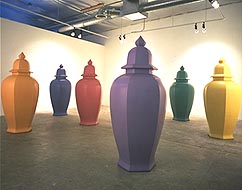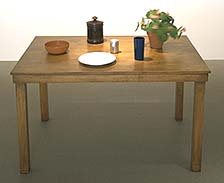
Andy Warhol. Skull. 1976.
Synthetic polymer paint and silkscreen on canvas.
72 1/8 x 80 1/2". The Andy Warhol Museum, Pittsburgh. Founding Collection, Contribution Dia Center for the Arts. ©1997 Andy Warhol Foundation for the Visual Arts/ARS, New York
May 25-August 26, 1997
Objects of Desire
THE MODERN STILL LIFE
Postmodern Simulacra
The ideologies and the political and economic framework of society today are vastly different from those at the dawn of this century. As the context for art made since the late 1970s or so, the postmodern world calls for a shift in the perception of still lifes from this period. Although the works in this group may examine subjects and even objects deriving from traditional still life themes (the vanitas, the domestic table, the vase of flowers), in their conception they differ quite strongly from apparently similar works of the past. Several of them may in fact be described as pastiches or simulacra of the still life — Andy Warhol's, Skull 1976, Robert Gober's Untitled, 1994-95, and Allan McCollum's Perfect Vehicles, 1988/89, for example, which appear intentionally neutral, mechanically executed, and of large or superhuman scale.
Other works are seemingly more conventional, showing objects assembled on a table, as in the classical still life. Even in these more recent variations on the theme, however, the table has become a reinterpretation and subversion of past examples. Charles Ray's Tabletop, 1989, appears at first glance to be a still life in the most literal sense: a table laid with domestic objects. Yet the objects are actually moving, or spinning, very slowly. The tables in this group by Ray, Mario Merz, and Robert Therrien, not to mention Cindy Sherman's photograph of one, raise provocative questions: is this a still life? Does a still life have to be painted, a representation, or still? What is the definition of a modern still life?
In the end, however, as different as the postmodern objects are, many of the works in this exhibition pose these or similar questions. In the twentieth century, the still life has proven itself a vital and evolving system of meanings, a visual language in which the most mundane and inanimate objects, transformed and recast, provide keys to understanding our thoughts, dreams, fears, and desires.
Margit Rowell
Chief Curator
Department of Drawings

Allan McCollum. Perfect Vehicles. 1988/89.
Moorglo on concrete. Each 80" high x 36" diameter. Collection the artist ©Allan McCollum

Domenico Gnoli. Without a Still Life. 1966.
Synthetic polymer paint and sand on canvas.
53 15/16 x 79 1/2". Staatliche Museen zu Berlin, Preussischer Kulturbesitz, Neue Nationalgalerie, Berlin

Charles Ray. Tabletop. 1989.
Wood table with ceramic plate, metal canister, plastic bowl, plastic tumbler, aluminum shaker, terra-cotta pot, plant, and motors. 43 x 52 1/2 x 35". Museum of Contemporary Art, Los Angeles. ©Charles Ray
